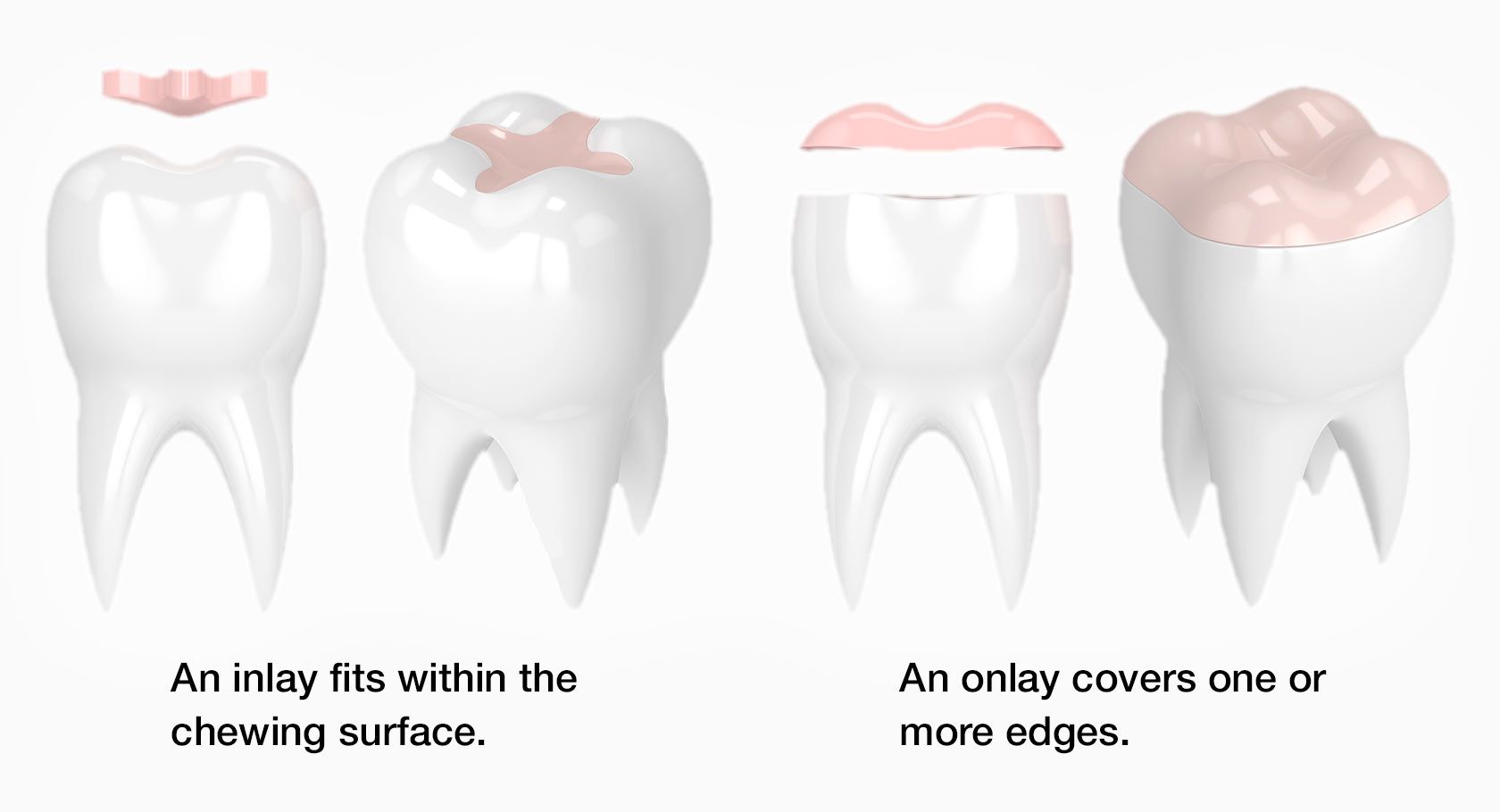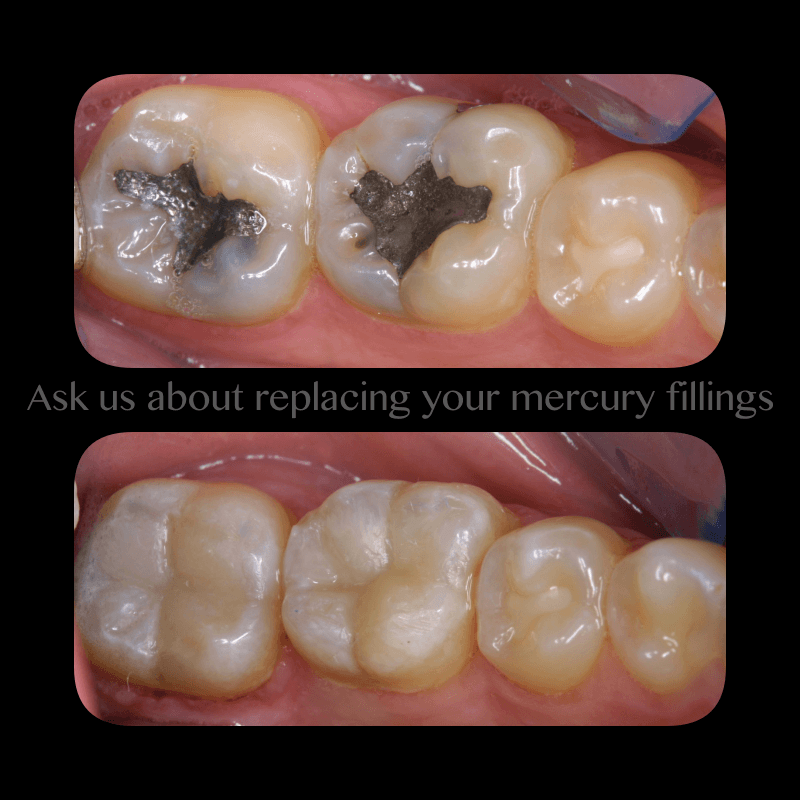
Inlays & Onlays
Inlays and Onlays are restorations used to repair back teeth that have a mild to moderate amount of decay. They can also be used to restore teeth that are cracked or fractured if the damage is not too severe to require a dental crown. Inlays and onlays are usually made from porcelain, and composite resin, inlays and onlays are often used to replace dark mercury fillings to achieve a more natural looking smile.
Dental Onlays
Tooth Onlays are designed to treat decay on the cusps, or top projections, of a tooth, they are used to treat decay that extends to one or more of the cusps. Onlays are placed in much the same way as inlays..
Like dental inlays, onlays are created from tooth-coloured material, which makes them virtually undetectable to the naked eye. This means that you will know that your restored teeth look as good as your natural teeth. Onlays also help to conserve more tooth structure because their use requires minimal removal a tooth’s surface. Perhaps their most important benefit is that, in saving damaged teeth, onlays help you avoid the eventual need for more extensive treatment with dental crowns, dental bridges, or dental implants.
Dental Inlays
Tooth inlays are used to treat teeth that have decay or damage positioned within the biting surfaces. They can also be used to replace old or damaged metal fillings, or simply to improve the cosmetic appeal of your teeth by removing the old metal fillings and replacing them with newer tooth – coloured restorations. Inlay placement is usually carried out over two appointments.
During your first visit to Dr Tehranian, he will assess what your needs are and if necessary, an impression of your tooth will be taken. After the impression is taken, a temporary inlay will be placed over the tooth. We will then send the impression off to our state of the art dental lab, which will then create the inlay for you that will match your tooth’s specifications. When you return back for your next appointment, the temporary inlay will be removed and the permanent one will be placed carefully over your tooth.
Benefits of Dental Inlays and Onlays
1- In treating dental decay, inlays and onlays help to eliminate tooth sensitivity and eventual tooth loss.
2- Since they can be made from tooth-coloured material, including porcelain and composite resin, inlays and onlays are virtually invisible.
3- Unlike metal fillings, inlays and onlays will not expand or contract in response to temperature changes caused by hot or cold foods. This change in size can cause teeth to weaken or fracture and cause pain or sensitivity.
4- The use of inlays and onlays requires less tooth reduction than does the use of metal fillings. This allows dentists to conserve more of a patient’s natural tooth structure in the treatment process.
5- Due to the way in which inlays and onlays are constructed, they help to strengthen teeth by up to 70%
6- Inlays and onlays can replace old silver (amalgam) fillings to create a healthier, more natural-looking smile.
Dental Inlays – Onlays – Fillings or Crowns
The earlier your dentist spots your tooth decay, the better. It means that the decay is easier to clear away, the cavity smaller and therefore easier to fill. But what happens when the decay is not spotted earlier? What happens when the tooth has already decayed considerably so that a filling will not be sufficient?
In immediate answer is that, where a filling is insufficient, a crown is required. A crown is needed when the tooth has decayed to such an extent that the tooth itself is not strong enough to hold a filling. Therefore, your dentist clears away the decay, shapes the remaining parts of the tooth and then the crown is quite literally placed over the top.
Therefore, in terms of procedures, it is quite a leap from a filling to a crown. A filling is quite often a relatively quick procedure that can be completed in just one visit. A crown is much more expensive to fit and requires at least two visits, as the mould needs to be taken then sent to a laboratory for the crown to be constructed.
So it is natural to look for a treatment which can sit neatly in between. Something stronger and more durable than a filling. Yet also something which is easier to fit than a crown and which allows you to salvage the remaining healthy parts of your existing tooth.
Onlays and inlays are deployed when the cavity is too large for a filling but the structure of the tooth is still sound. Therefore, rather than re-shaping a sound tooth to fit under a crown, your dentist can simply use an inlay or onlay. An inlay fills the gap in the tooth while the onlay is applied to the top of the tooth – but apart from positioning they essentially play the same function.
Usually, inlays and onlays are used to restore the back teeth as these are the teeth that do the most work, are the hardest to clean and often suffer the most from decay. Sometimes, they are also used to replace older amalgam fillings. The reason for this is because onlays and inlays can be manufactured from tooth-coloured materials, such as composite resin or porcelain.


How long do inlays and onlays last?
Dental inlays and onlays can potentially last for decades, however, it depends entirely on a number of factors. A key influence on how long they exist is the material that the inlay or onlay is composed of. Also, the actual teeth that the product is applied to can be a big determining factor in how long they last for.
Other factors that can affect how much a dental inlay and/or onlay will endure are very dependent on the patient’s actions after the filling-like product has been fixed. These influences are how forceful chewing is as well as choice of food, the level of care that is taken by the patient for the inlays or onlays as well as the oral hygiene routine of the patient. It is also important that the dentist is visited regularly to make sure that the inlays and onlays are intact.
Dental Filling Vs The Inlay
In theory, these two can often be used interchangeably, but inlays are typically reserved for much larger cavities. They both involve removing the existing cavity with a drill and filling that empty space, but how that space is filled is where they primarily differ. With a filling, an amalgam or composite material is used to fill the space, and it’s a much quicker process, involving only a single visit.
With an inlay, the space is filled with a single, solid piece that is usually fabricated in a lab, although they can sometimes be made in-office, and they are typically made out of a material like gold or ceramic. The inlay must be made precisely to the shape and size of the empty space, otherwise food and bacteria will enter the space, resulting in further decay. The upside to an inlay is that they do not contract to the same degree as a filling after being placed, so there is less chance of the restoration failing for that reason, or creating a gap between the filling and the surrounding tooth structure. Inlays also create a tougher and theoretically more durable surface for use when chewing, and as such, an inlay should be more reliable long term, although the data on that is mixed and inconclusive.
Onlays Vs Dental Crowns
These are your more major single-tooth restorations, reserved for larger areas of decay where a filling or inlay won’t work due to the amount of tooth structure that must be removed. The primary distinction between an onlay and an inlay is that an onlay will cover a cusp of the tooth, whereas an inlay only fills the area between the cusps. The cavity is still drilled from the tooth, and an onlay is fabricated to the exact size and shape of the space. Conversely, a crown will cover the entire biting surface of the tooth, as well as the tooth structure above the gum line.
Compared to a crown, an onlay is a less aggressive restoration when one can be performed, as less tooth structure needs to be removed in order to place the onlay. The costs are similar, but an onlay is a little cheaper than a crown. As such, an onlay is actually the preferred restoration when possible.
What are onlays and inlays made from?
Like fillings, inlays and onlays are usually made from porcelain or composite resin to blend naturally with the rest of your teeth and provide lasting strength and reinforcement to your otherwise damaged tooth. It is possible to get gold and amalgam inlays and onlays, however composite resin and porcelain choices make for a solution that is hardly noticeable.
How dental inlays and onlays are applied?
In general, the process of fixing inlays or onlays onto the teeth requires at least two dental appointments. This is because the inlays and onlays must be moulded perfectly to the size and shaped of the individual teeth that require the product.
At the first appointment, your dentist will extract the damaged part of the tooth. Then the part of the tooth that is remaining will be carefully shaped to ensure that the inlay or onlay will be able to stick. This shaped tooth provides the model for an impression to be made. A gum will be put inside your mouth so the dentist can make a mould of the tooth shape as well as your bite. This mould is an exact replica of your mouth so the inlays and onlays can be perfectly constructed in the laboratory.

The art of preserving your natural teeth
When it comes to dentistry, our experts work hard to maintain and keep your teeth as healthy as possible for as long as possible. The longer you can keep your natural teeth, the better it is for your overall oral health. Inlays and onlays are a method of preserving teeth which have been attacked by decay. While crowns are an option for damaged teeth, they often require your dentist to file down or remove a little of your existing tooth, in order for the sleeve to fit nicely over the top and stay in line with your existing teeth. Onlays and inlays fit onto your teeth in a way that maintains all or most of your current tooth structure.
Office
407 Blackpool Road , Preston , Lancashire
Contact Us
(01772) 726932
